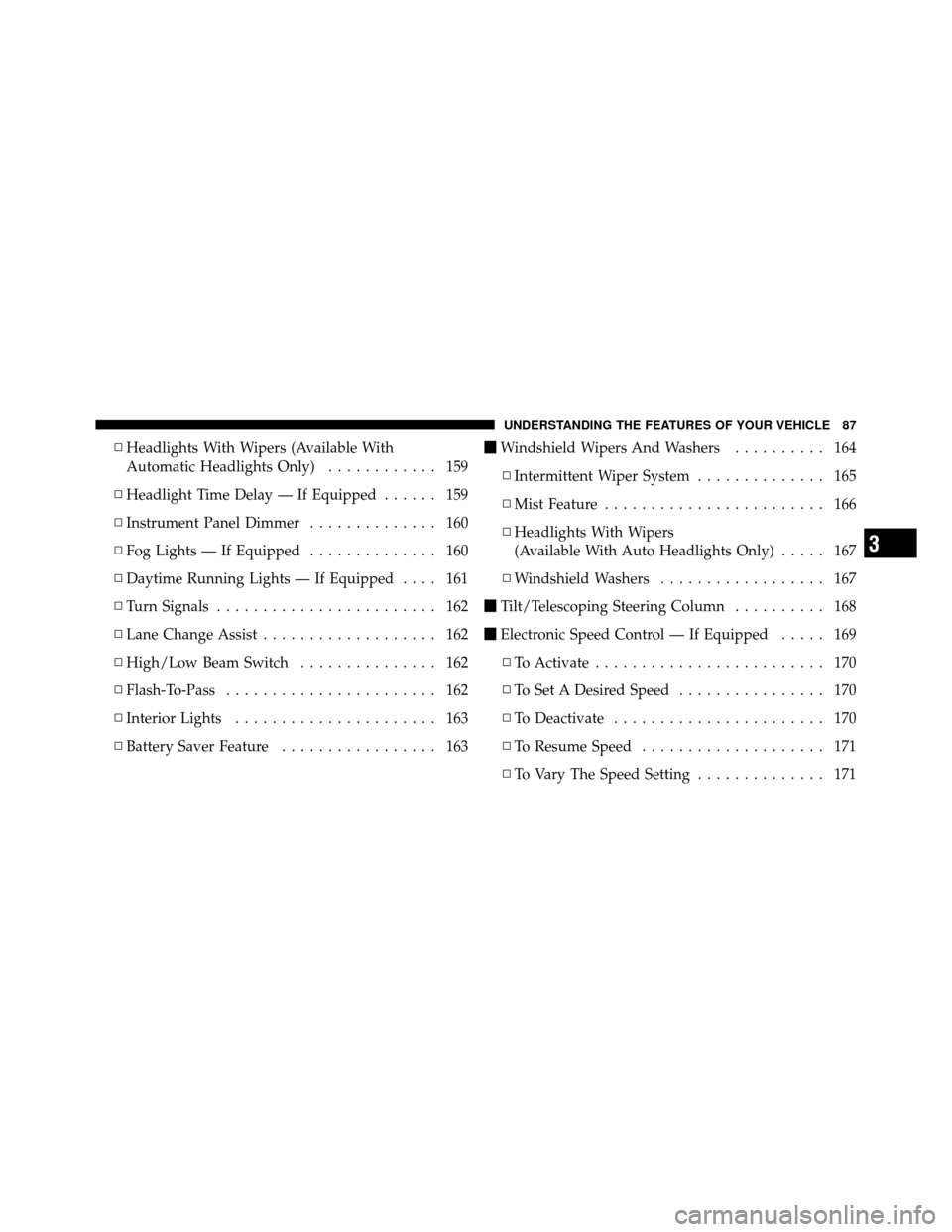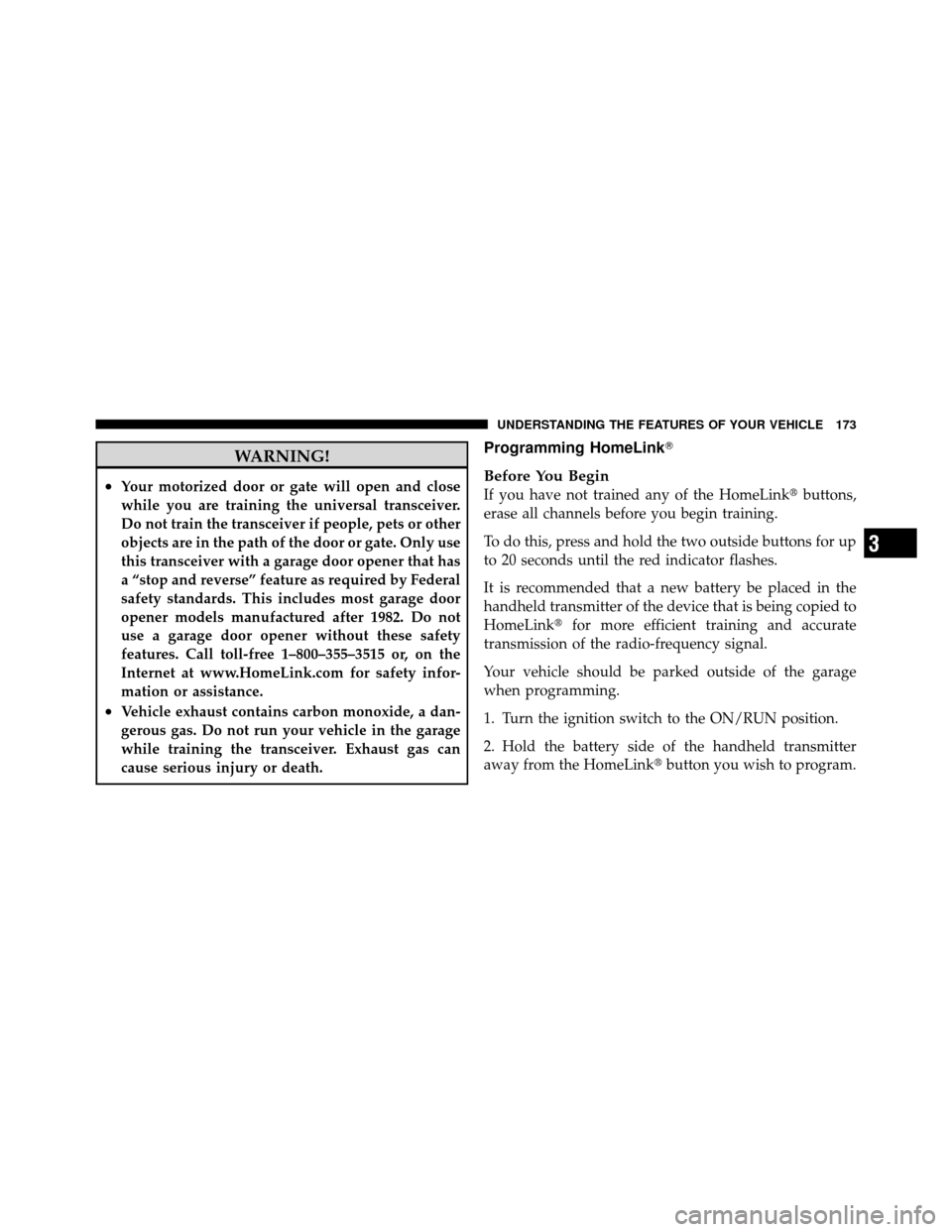Page 89 of 505

▫Headlights With Wipers (Available With
Automatic Headlights Only) ............ 159
▫ Headlight Time Delay — If Equipped ...... 159
▫ Instrument Panel Dimmer .............. 160
▫ Fog Lights — If Equipped .............. 160
▫ Daytime Running Lights — If Equipped .... 161
▫ Turn Signals ........................ 162
▫ Lane Change Assist ................... 162
▫ High/Low Beam Switch ............... 162
▫ Flash-To-Pass ....................... 162
▫ Interior Lights ...................... 163
▫ Battery Saver Feature ................. 163 �
Windshield Wipers And Washers .......... 164
▫ Intermittent Wiper System .............. 165
▫ Mist Feature ........................ 166
▫ Headlights With Wipers
(Available With Auto Headlights Only) ..... 167
▫ Windshield Washers .................. 167
� Tilt/Telescoping Steering Column .......... 168
� Electronic Speed Control — If Equipped ..... 169
▫ To Activate ......................... 170
▫ To Set A Desired Speed ................ 170
▫ To Deactivate ....................... 170
▫ To Resume Speed .................... 171
▫ To Vary The Speed Setting .............. 171
3
UNDERSTANDING THE FEATURES OF YOUR VEHICLE 87
Page 93 of 505

•Opening and closing the top consecutively without the
engine running may run the battery down.
•If a fluttering noise is heard from the rear seat belts
while driving with the top down, safely bring the
vehicle to a stop and buckle the rear seat belts over the
empty seats. This will keep tension on the seat belts
and remove the fluttering condition.
CAUTION!
•Correctly position the cargo shield in the trunk
before stowing the top. Doing so closes a switch
that allows top operation (stowing) to proceed. If
the switch is not closed, a warning message dis-
plays in the instrument cluster to notify the driver.
•Always place items carefully into the trunk.(Continued)
CAUTION! (Continued)
•Do not push items too far into the trunk, particu-
larly when the top is retracted into its stowage area
in the trunk.
•Do not use the area on top of the tonneau cover for
storage.
Failure to follow these cautions can cause damage
to the convertible top components, trunk contents,
cargo shield, and the vehicle interior.
CAUTION!
Before operating the power top:
•Always check on top of the tonneau cover area to
be sure that it is clear of debris or other items.
•Make sure the ambient temperature is above 0°F
(-18°C).(Continued)
3
UNDERSTANDING THE FEATURES OF YOUR VEHICLE 91
Page 108 of 505

\b\b\bThe PTCM will lockout the power convertible top system if the vehicle charging system is malfunction-
ing, or the battery is run down, or the hydraulic pump is overheating. In addition, the system prohibits lower-
ing the top when ambient temperature is at 0°F (-18°C) or lower and raising the top when ambient temperature
is below -40°F (-40°C).
• If you are trying to lower the top and ambient temperature is 0°F (-18°C) or lower, wait until the temperature
rises and the top is thawed and dry before operating the power top. A soft top should not be lowered at tem-
peratures below 32°F (0°C).
• If you are trying to raise the top and ambient temperature is below -40°F (-40°C), wait until the temperature
rises before operating the power top.
• If the vehicle charging system is malfunctioning, see your authorized dealer for service.
• If the battery is run down, have it recharged and tested at your authorized dealer.
• Hydraulic pump overheating can occur if you lower and raise the top consecutively (usually more than six or
seven times depending upon the ambient temperature). Wait at least five minutes before operating the power
top again. NOTE:If lockout occurs due to hydraulic pump overheating, the system will allow you to raise the
top without waiting five minutes. However, do so only if necessary.
106 UNDERSTANDING THE FEATURES OF YOUR VEHICLE
Page 125 of 505

•After the “Ready” prompt and the following beep, say
“Redial”.
•The Uconnect™ Phone will call the last number that
was dialed from your mobile phone.
NOTE: This may not be the last number dialed from the
Uconnect™ Phone.
Call Continuation
Call continuation is the progression of a phone call on the
Uconnect™ Phone after the vehicle ignition key has been
switched to OFF. Call continuation functionality avail-
able on the vehicle can be any one of three types:
•After the ignition key is switched to OFF, a call can
continue on the Uconnect™ Phone either until the call
ends, or until the vehicle battery condition dictates
cessation of the call on the Uconnect™ Phone and
transfer of the call to the mobile phone.
•After the ignition key is switched to OFF, a call can
continue on the Uconnect™ Phone for a certain dura-
tion, after which the call is automatically transferred
from the Uconnect™ Phone to the mobile phone.
•An active call is automatically transferred to the
mobile phone after the ignition key is switched to OFF.
Uconnect™ Phone Features
Language Selection
To change the language that the Uconnect™ Phone is
using:
•Press thebutton to begin.
•After the “Ready” prompt and the following beep, say
the name of the language you wish to switch to
English, Espanol, or Francais.
•Continue to follow the system prompts to complete
the language selection.
3
UNDERSTANDING THE FEATURES OF YOUR VEHICLE 123
Page 129 of 505

Barge In — Overriding Prompts
The “Voice Command” button can be used when you
wish to skip part of a prompt and issue your voice
command immediately. For example, if a prompt is
asking “Would you like to pair a phone, clear a...,” you
could press the
button and say, “Pair a Phone” to
select that option without having to listen to the rest of
the voice prompt.
Turning Confirmation Prompts ON/OFF
Turning confirmation prompts off will stop the system
from confirming your choices (e.g., the Uconnect™
Phone will not repeat a phone number before you dial it).
•Press thebutton to begin.
•After the “Ready” prompt and the following beep, say
one of the following:
�“Setup Confirmation Prompts On”
�“Setup Confirmation Prompts Off”
Phone And Network Status Indicators
If available on the radio and/or on a premium display
such as the instrument panel cluster, and supported by
your mobile phone, the Uconnect™ Phone will provide
notification to inform you of your phone and network
status when you are attempting to make a phone call
using Uconnect™ Phone. The status is given for network
signal strength, phone battery strength, etc.
Dialing Using The Mobile Phone Keypad
You can dial a phone number with your mobile phone
keypad and still use the Uconnect™ Phone (while dialing
via the mobile phone keypad, the user must exercise
caution and take precautionary safety measures). By
dialing a number with your paired Bluetooth� mobile
phone, the audio will be played through your vehicle’s
audio system. The Uconnect™ Phone will work the same
as if you dial the number using Voice Command.
3
UNDERSTANDING THE FEATURES OF YOUR VEHICLE 127
Page 165 of 505
Interior Lights
Two courtesy/reading lights are located in the bottom of
the rearview mirror. You can turn these lights on and off
from the switches in the mirror or from the dimmer
control in the multifunction lever. These lights are also
controlled automatically by the Illuminated Entry Sys-
tem.A courtesy light is also found in the rear of the center
console. You can turn this light on and off from the
dimmer control in the multifunction lever. This light is
also controlled automatically by the Illuminated Entry
System.
Battery Saver Feature
To protect the battery, the interior lights will turn off
automatically 10 minutes after the ignition switch is
moved to the LOCK position. This will occur if the
interior lights were switched on manually or are on
because a door is open.
Courtesy/Reading Light Switches
3
UNDERSTANDING THE FEATURES OF YOUR VEHICLE 163
Page 174 of 505
On steep hills, a greater speed loss or gain may occur so
it may be preferable to drive without Electronic Speed
Control.
WARNING!
Electronic Speed Control can be dangerous where the
system cannot maintain a constant speed. Your ve-
hicle could go too fast for the conditions, and you
could lose control and have an accident. Do not use
Electronic Speed Control in heavy traffic or on roads
that are winding, icy, snow-covered or slippery.
GARAGE DOOR OPENER — IF EQUIPPED
HomeLink�replaces up to three remote controls (hand-
held transmitters) that operate devices such as garage
door openers, motorized gates, lighting or home security
systems. The HomeLink� unit operates off your vehicle’s
battery. The HomeLink�
buttons that are located in the headliner
or sun visor designate the three different HomeLink�
channels.
NOTE: HomeLink� is disabled when the Vehicle Secu-
rity Alarm is active.
HomeLink� Buttons
172 UNDERSTANDING THE FEATURES OF YOUR VEHICLE
Page 175 of 505

WARNING!
•Your motorized door or gate will open and close
while you are training the universal transceiver.
Do not train the transceiver if people, pets or other
objects are in the path of the door or gate. Only use
this transceiver with a garage door opener that has
a “stop and reverse” feature as required by Federal
safety standards. This includes most garage door
opener models manufactured after 1982. Do not
use a garage door opener without these safety
features. Call toll-free 1–800–355–3515 or, on the
Internet at www.HomeLink.com for safety infor-
mation or assistance.
•Vehicle exhaust contains carbon monoxide, a dan-
gerous gas. Do not run your vehicle in the garage
while training the transceiver. Exhaust gas can
cause serious injury or death.
Programming HomeLink�
Before You Begin
If you have not trained any of the HomeLink�buttons,
erase all channels before you begin training.
To do this, press and hold the two outside buttons for up
to 20 seconds until the red indicator flashes.
It is recommended that a new battery be placed in the
handheld transmitter of the device that is being copied to
HomeLink� for more efficient training and accurate
transmission of the radio-frequency signal.
Your vehicle should be parked outside of the garage
when programming.
1. Turn the ignition switch to the ON/RUN position.
2. Hold the battery side of the handheld transmitter
away from the HomeLink� button you wish to program.
3
UNDERSTANDING THE FEATURES OF YOUR VEHICLE 173